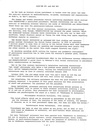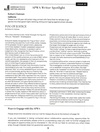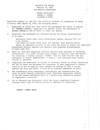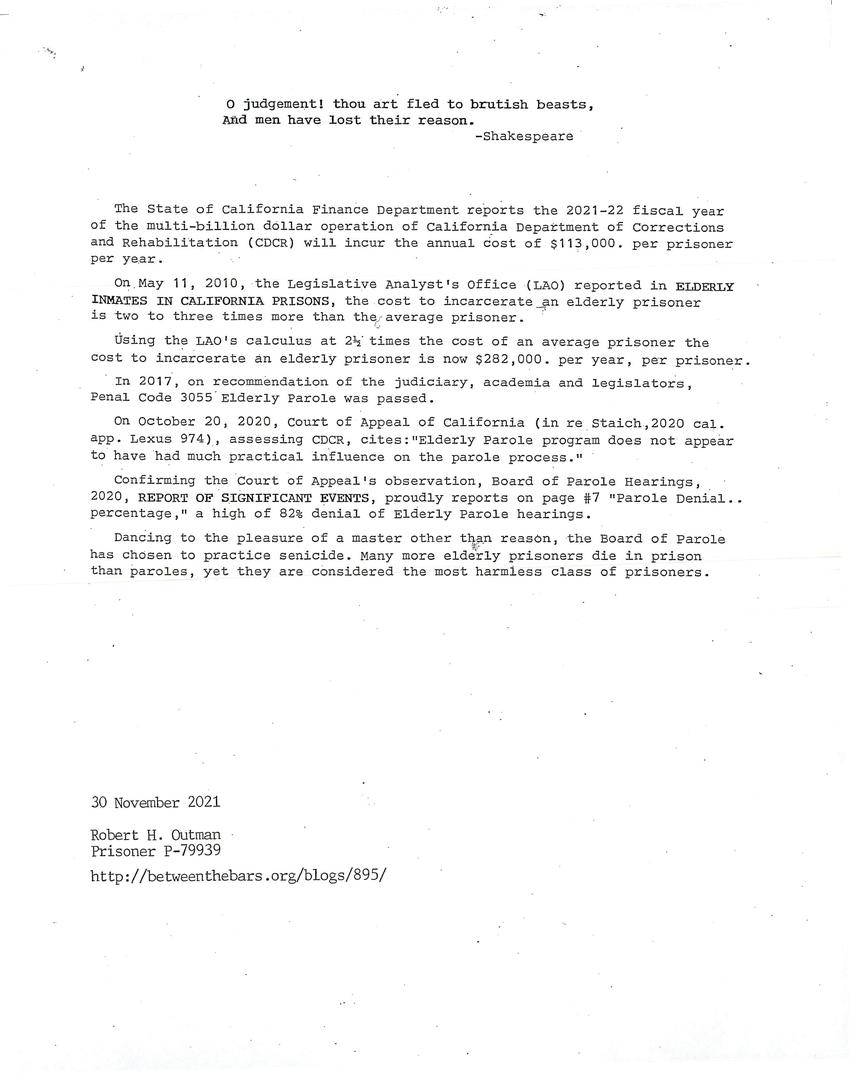
Transcription
O judgment! thou art fled to brutish beasts,
And men have lost their reason.
—Shakespeare
The State of California Finance Department reports the 2021-22 fiscal year of the multibillion dollar operation of California Department of Corrections and Rehabilitation (CDCR) will incur the annual cost of $113,00 per prisoner per year.
On May 11, 2010, the Legislative Analyst's Office (LAC) reported in ELDERLY INMATES IN CALIFORNIA PRISONS, the cost to incarcerate an elderly prisoner is two to three times more than the average prisoner.
Using the LAO's calculations at 2 1/2 times the cost of an average prisoner, the cost to incarcerate an elderly prisoner is now $282,00 per year, per prisoner.
On 2017, on recommendation of the judiciary, academia, and legislators, Penal Code 3055 Elderly Parole was passed.
On October 20, 2020, Court of Appeal of California (in re Staich, 2020 cal. app. Lexus 974), assessing CDCR, cites: "Elderly Parole program does not appear to have had much practical influence on the parole process."
Confirming the Court of Appeal's observation, Board of Parole Hearings, 2020, REPORT OF SIGNIFICANT EVENTS, proudly reports on page #7 "Parole Denial... percentage," a high of 82% denial of Elderly Parole hearings.
Dancing to the pleasure of a master other than reason, the Board of Parole has chosen to practice senicide. Many more elderly prisoners die in prison than paroles, yet they are considered the most harmless class of prisoners.
30 November 2021
Robert H. Outman
Prisoner P-79939
http://betweenthebars.org/blogs/895/
Other posts by this author
|
2025 oct 5

|
2025 sep 23

|
2025 aug 3

|
2025 jun 25

|
2025 jun 25

|
2025 may 10

|
More... |


Replies (3)
Thank you for your post. It caused me to look up my own state's code concerning the release of inmates in medical distress. If other readers would like to see their state's view on Medical and Geriatric Parole law, it is easily found at the National Conference of State Legislatures website. Each state is listed there along with the applicable code citation of state law. Each state, with the exceptions of Arizona, Illinois, Iowa, and West Virginia, address this pressing issue. Texas and Alabama are reported as having the highest rates of release based on the statute. It also reports the release rate of Texas was 4.3% of requests in the year 2016. This dismal statistic is depressive and a poor reflection on the humane treatment of medically distressed inmates.
You report the current rate of California is higher than this statistic (after the new 2017 law), so perhaps there is hope that American can practice mercy and forgiveness on those inmates who deserve to die in the arms of family...at least those blessed with family. Anyone who has experienced sickness or the death of a loved one knows the precious power of love. May we each support the humane treatment of those inmates whose sickness, infirmity, or frailty, makes them no threat to society.
Father John
A federal study showed among healthy offenders age 65 and over the recidivism rate was 13% over an eight year followup after release compared to 67% recidivism rate for those released at 21 years old. I think this study should have delved deeper into the question of the state of health at the time of release, rather than the age. Terminal conditions should be given special consideration, it is humane. The antidotal evidence you cite Robert is heart-breaking. Who would have a good attitude in the circumstances of a medical unit? I have visited infirmaries and the conditions are far from ideal for healing or rehabilitation.
Staff shortages nationwide force the nurse to offender ratio into the inhumane category. Pain control, regularity of required meds, and mental health issues and symptoms associated with elderly conditions, all contribute to the insufficiency of the system to handle "quality of life" health care. If the humanity issue does not get your attention, perhaps the cost of required standards of care should. As more medical systems are outsourced and infirmaries are treated as cost and profit centers, the actual and hidden costs of incarcerating the elderly is ballooning out of control while at the same time, the quality of care is shrinking rapidly.
More than all that, this is a dignity-of-life issue. Pope Francis puts it like this..."We have created a "throw away" culture which is now spreading. It is no longer simply about exploitation and oppression, but something new. Exclusion ultimately has to do with what it means to be a part of the society in which we live; those excluded are no longer society's underside or its fringes or its disenfranchised – they are no longer even a part of it. The excluded are not the "exploited" but the outcast, the "leftovers".
Is this how ANYONE should be treated? As leftovers? It is time we look at ourselves America and ask, what have we become when someone with dementia or crippling age-related sickness is warehoused in what is essentially a death camp? Come on America, we can do better.